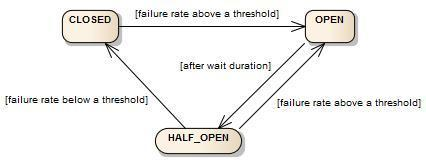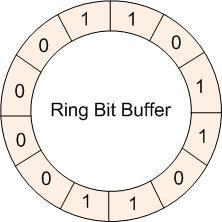Circuitbreaker
简介
CircuitBreaker通过具有三种正常状态的有限状态机实现:CLOSED,OPEN 和HALF_OPEN以及两个特殊状态DISABLED和FORCED_OPEN。当熔断器关闭时,所有的请求都会通过熔断器。如果失败率超过设定的阈值,熔断器就会从关闭状态转换到打开状态,这时所有的请求都会被拒绝。当经过一段时间后,熔断器会从打开状态转换到半开状态,这时仅有一定数量的请求会被放入,并重新计算失败率,如果失败率超过阈值,则变为打开状态,如果失败率低于阈值,则变为关闭状态。

Resilience4j记录请求状态的数据结构和Hystrix不同,Hystrix是使用滑动窗口来进行存储的,而Resilience4j采用的是Ring Bit Buffer(环形缓冲区)。Ring Bit Buffer在内部使用BitSet这样的数据结构来进行存储,BitSet的结构如下图所示:

每一次请求的成功或失败状态只占用一个bit位,与boolean数组相比更节省内存。BitSet使用long[]数组来存储这些数据,意味着16个值(64bit)的数组可以存储1024个调用状态。
计算失败率需要填满环形缓冲区。例如,如果环形缓冲区的大小为10,则必须至少请求满10次,才会进行故障率的计算,如果仅仅请求了9次,即使9个请求都失败,熔断器也不会打开。但是CLOSE状态下的缓冲区大小设置为10并不意味着只会进入10个 请求,在熔断器打开之前的所有请求都会被放入。
当故障率高于设定的阈值时,熔断器状态会从由CLOSE变为OPEN。这时所有的请求都会抛出CallNotPermittedException异常。当经过一段时间后,熔断器的状态会从OPEN变为HALF_OPEN,HALF_OPEN状态下同样会有一个Ring Bit Buffer,用来计算HALF_OPEN状态下的故障率,如果高于配置的阈值,会转换为OPEN,低于阈值则装换为CLOSE。与CLOSE状态下的缓冲区不同的地方在于,HALF_OPEN状态下的缓冲区大小会限制请求数,只有缓冲区大小的请求数会被放入。
除此以外,熔断器还会有两种特殊状态:DISABLED(始终允许访问)和FORCED_OPEN(始终拒绝访问)。这两个状态不会生成熔断器事件(除状态装换外),并且不会记录事件的成功或者失败。退出这两个状态的唯一方法是触发状态转换或者重置熔断器。
熔断器关于线程安全的保证措施有以下几个部分:
- 熔断器的状态使用AtomicReference保存的
- 更新熔断器状态是通过无状态的函数或者原子操作进行的
- 更新事件的状态用synchronized关键字保护
意味着同一时间只有一个线程能够修改熔断器状态或者记录事件的状态。
可配置参数
| 配置参数 | 默认值 | 描述 |
|---|---|---|
| failureRateThreshold | 50 | 熔断器关闭状态和半开状态使用的同一个失败率阈值 |
| ringBufferSizeInHalfOpenState | 10 | 熔断器半开状态的缓冲区大小,会限制线程的并发量,例如缓冲区为10则每次只会允许10个请求调用后端服务 |
| ringBufferSizeInClosedState | 100 | 熔断器关闭状态的缓冲区大小,不会限制线程的并发量,在熔断器发生状态转换前所有请求都会调用后端服务 |
| waitDurationInOpenState | 60(s) | 熔断器从打开状态转变为半开状态等待的时间 |
| automaticTransitionFromOpenToHalfOpenEnabled | false | 如果置为true,当等待时间结束会自动由打开变为半开,若置为false,则需要一个请求进入来触发熔断器状态转换 |
| recordExceptions | empty | 需要记录为失败的异常列表 |
| ignoreExceptions | empty | 需要忽略的异常列表 |
| recordFailure | throwable -> true | 自定义的谓词逻辑用于判断异常是否需要记录或者需要忽略,默认所有异常都进行记录 |
测试前准备
首先引入maven依赖:
<dependency>
<groupId>io.github.resilience4j</groupId>
<artifactId>resilience4j-spring-boot2</artifactId>
<version>1.6.1</version>
</dependency>resilience4j-spring-boot2 集成了circuitbeaker、retry、bulkhead、ratelimiter、timelimiter 几个模块。
application.yml 配置
resilience4j:
circuitbreaker:
configs:
default:
ringBufferSizeInClosedState: 5 # 熔断器关闭时的缓冲区大小
ringBufferSizeInHalfOpenState: 2 # 熔断器半开时的缓冲区大小
waitDurationInOpenState: 10000 # 熔断器从打开到半开需要的时间
failureRateThreshold: 60 # 熔断器打开的失败阈值
eventConsumerBufferSize: 10 # 事件缓冲区大小
registerHealthIndicator: true # 健康监测
automaticTransitionFromOpenToHalfOpenEnabled: false # 是否自动从打开到半开,不需要触发
recordFailurePredicate: com.example.resilience4j.exceptions.RecordFailurePredicate # 谓词设置异常是否为失败
recordExceptions: # 记录的异常
- com.example.resilience4j.exceptions.BusinessBException
- com.example.resilience4j.exceptions.BusinessAException
ignoreExceptions: # 忽略的异常
- com.example.resilience4j.exceptions.BusinessAException
instances:
backendA:
baseConfig: default
waitDurationInOpenState: 5000
failureRateThreshold: 20
backendB:
baseConfig: default可以配置多个熔断器实例,使用不同配置或者覆盖配置。
需要保护的后端服务
以一个查找用户列表的后端服务为例,利用熔断器保护该服务。
interface RemoteService {
List<User> process() throws TimeoutException, InterruptedException;
}连接器调用该服务
这是调用远端服务的连接器,我们通过调用连接器中的方法来调用后端服务。
public RemoteServiceConnector{
public List<User> process() throws TimeoutException, InterruptedException {
List<User> users;
users = remoteServic.process();
return users;
}
}用于监控熔断器状态及事件的工具类
要想学习各个配置项的作用,需要获取特定时候的熔断器状态,写一个工具类:
import io.github.resilience4j.circuitbreaker.CircuitBreaker;
import lombok.extern.slf4j.Slf4j;
@Slf4j
public class CircuitBreakerUtil {
/**
* @Description: 获取熔断器的状态
*/
public static void getCircuitBreakerStatus(String time, CircuitBreaker circuitBreaker){
CircuitBreaker.Metrics metrics = circuitBreaker.getMetrics();
// Returns the failure rate in percentage.
float failureRate = metrics.getFailureRate();
// Returns the current number of buffered calls.
int bufferedCalls = metrics.getNumberOfBufferedCalls();
// Returns the current number of failed calls.
int failedCalls = metrics.getNumberOfFailedCalls();
// Returns the current number of successed calls.
int successCalls = metrics.getNumberOfSuccessfulCalls();
// Returns the current number of not permitted calls.
long notPermittedCalls = metrics.getNumberOfNotPermittedCalls();
// Returns the current total number of calls which were slower than a certain threshold.
int slowCalls = metrics.getNumberOfSlowCalls();
// Returns the current number of failed calls which were slower than a certain threshold.
int slowFailedCalls = metrics.getNumberOfSlowFailedCalls();
// Returns the current number of successful calls which were slower than a certainthreshold.
int slowSuccessfulCalls = metrics.getNumberOfSlowSuccessfulCalls();
log.info(time + "state=" +circuitBreaker.getState() + " , metrics[ failureRate=" + failureRate +
", bufferedCalls=" + bufferedCalls +
", failedCalls=" + failedCalls +
", successCalls=" + successCalls +
", notPermittedCalls=" + notPermittedCalls +
", slowCalls=" + slowCalls +
", slowFailedCalls=" + slowFailedCalls +
", slowSuccessfulCalls=" + slowSuccessfulCalls +
" ]"
);
}
/**
* @Description: 监听熔断器事件
*/
public static void addCircuitBreakerListener(CircuitBreaker circuitBreaker){
circuitBreaker.getEventPublisher()
.onSuccess(event -> log.info("服务调用成功:" + event.toString()))
.onError(event -> log.info("服务调用失败:" + event.toString()))
.onIgnoredError(event -> log.info("服务调用失败,但异常被忽略:" + event.toString()))
.onReset(event -> log.info("熔断器重置:" + event.toString()))
.onStateTransition(event -> log.info("熔断器状态改变:" + event.toString()))
.onCallNotPermitted(event -> log.info("熔断器状态改变:" + event.toString()))
.onFailureRateExceeded(event -> log.info("熔断器状态改变:" + event.toString()))
.onSlowCallRateExceeded(event -> log.info("熔断器状态改变:" + event.toString()))
.onCallNotPermitted(event -> log.info(" 熔断器已经打开:" + event.toString()));
}
}调用方法
CircuitBreaker目前支持两种方式调用,一种是程序式调用,一种是AOP使用注解的方式调用。
程序式的调用方法
在CircuitService中先注入注册器,然后用注册器通过熔断器名称获取熔断器。如果不需要使用降级函数,可以直接调用熔断器的executeSupplier方法或executeCheckedSupplier方法:
public class CircuitBreakerServiceImpl{
@Autowired
private CircuitBreakerRegistry circuitBreakerRegistry;
public List<User> circuitBreakerNotAOP() throws Throwable {
CircuitBreaker circuitBreaker = circuitBreakerRegistry.circuitBreaker("backendA");
CircuitBreakerUtil.getCircuitBreakerStatus("执行开始前:", circuitBreaker);
circuitBreaker.executeCheckedSupplier(remotServiceConnector::process);
}
}
如果需要使用降级函数,则要使用decorate包装服务的方法,再使用Try.of().recover()进行降级处理,同时也可以根据不同的异常使用不同的降级方法:
public class CircuitBreakerServiceImpl {
@Autowired
private RemoteServiceConnector remoteServiceConnector;
@Autowired
private CircuitBreakerRegistry circuitBreakerRegistry;
public List<User> circuitBreakerNotAOP(){
// 通过注册器获取熔断器的实例
CircuitBreaker circuitBreaker = circuitBreakerRegistry.circuitBreaker("backendA");
CircuitBreakerUtil.getCircuitBreakerStatus("执行开始前:", circuitBreaker);
// 使用熔断器包装连接器的方法
CheckedFunction0<List<User>> checkedSupplier = CircuitBreaker.
decorateCheckedSupplier(circuitBreaker, remoteServiceConnector::process);
// 使用Try.of().recover()调用并进行降级处理
Try<List<User>> result = Try.of(checkedSupplier).
recover(CallNotPermittedException.class, throwable -> {
log.info("熔断器已经打开,拒绝访问被保护方法~");
CircuitBreakerUtil
.getCircuitBreakerStatus("熔断器打开中:", circuitBreaker);
List<User> users = new ArrayList();
return users;
})
.recover(throwable -> {
log.info(throwable.getLocalizedMessage() + ",方法被降级了~~");
CircuitBreakerUtil
.getCircuitBreakerStatus("降级方法中:",circuitBreaker);
List<User> users = new ArrayList();
return users;
});
CircuitBreakerUtil.getCircuitBreakerStatus("执行结束后:", circuitBreaker);
return result.get();
}
}
AOP式的调用方法
首先在连接器方法上使用@CircuitBreaker(name=””,fallbackMethod=””)注解,其中name是要使用的熔断器的名称,fallbackMethod是要使用的降级方法,降级方法必须和原方法放在同一个类中,且降级方法的返回值需要和原方法相同,输入参数需要添加额外的exception参数,类似这样:
public RemoteServiceConnector{
@CircuitBreaker(name = "backendA", fallbackMethod = "fallBack")
public List<User> process() throws TimeoutException, InterruptedException {
List<User> users;
users = remoteServic.process();
return users;
}
private List<User> fallBack(Throwable throwable){
log.info(throwable.getLocalizedMessage() + ",方法被降级了~~");
CircuitBreakerUtil.getCircuitBreakerStatus("降级方法中:", circuitBreakerRegistry.circuitBreaker("backendA"));
List<User> users = new ArrayList();
return users;
}
private List<User> fallBack(CallNotPermittedException e){
log.info("熔断器已经打开,拒绝访问被保护方法~");
CircuitBreakerUtil.getCircuitBreakerStatus("熔断器打开中:", circuitBreakerRegistry.circuitBreaker("backendA"));
List<User> users = new ArrayList();
return users;
}
}可使用多个降级方法,保持方法名相同,同时满足的条件的降级方法会触发最接近的一个(这里的接近是指类型的接近,先会触发离它最近的子类异常),例如如果process()方法抛出CallNotPermittedException,将会触发fallBack(CallNotPermittedException e)方法而不会触发fallBack(Throwable throwable)方法。之后直接调用方法就可以了:
public class CircuitBreakerServiceImpl {
@Autowired
private RemoteServiceConnector remoteServiceConnector;
@Autowired
private CircuitBreakerRegistry circuitBreakerRegistry;
public List<User> circuitBreakerAOP() throws TimeoutException, InterruptedException {
CircuitBreakerUtil
.getCircuitBreakerStatus("执行开始前:",circuitBreakerRegistry.circuitBreaker("backendA"));
List<User> result = remoteServiceConnector.process();
CircuitBreakerUtil
.getCircuitBreakerStatus("执行结束后:", circuitBreakerRegistry.circuitBreaker("backendA"));
return result;
}
}
使用测试
接下来进入测试,首先我们定义了两个异常,异常A同时在黑白名单中,异常B只在黑名单中:
recordExceptions: # 记录的异常
- com.example.resilience4j.exceptions.BusinessBException
- com.example.resilience4j.exceptions.BusinessAException
ignoreExceptions: # 忽略的异常
- com.example.resilience4j.exceptions.BusinessAException
然后对被保护的后端接口进行如下的实现:
public class RemoteServiceImpl implements RemoteService {
private static AtomicInteger count = new AtomicInteger(0);
public List<User> process() {
int num = count.getAndIncrement();
log.info("count的值 = " + num);
if (num % 4 == 1){
throw new BusinessAException("异常A,不需要被记录");
}
if (num % 4 == 2 || num % 4 == 3){
throw new BusinessBException("异常B,需要被记录");
}
log.info("服务正常运行,获取用户列表");
// 模拟数据库的正常查询
return repository.findAll();
}
}使用CircuitBreakerServiceImpl中的AOP或者程序式调用方法进行单元测试,循环调用10次:
public class CircuitBreakerServiceImplTest{
@Autowired
private CircuitBreakerServiceImpl circuitService;
@Test
public void circuitBreakerTest() {
for (int i=0; i<10; i++){
// circuitService.circuitBreakerAOP();
circuitService.circuitBreakerNotAOP();
}
}
}看下运行结果:
执行开始前:state=CLOSED , metrics[ failureRate=-1.0, bufferedCalls=0, failedCalls=0, successCalls=0, maxBufferCalls=5, notPermittedCalls=0 ]
count的值 = 0
服务正常运行,获取用户列表
执行结束后:state=CLOSED , metrics[ failureRate=-1.0, bufferedCalls=1, failedCalls=0, successCalls=1,
执行开始前:state=CLOSED , metrics[ failureRate=-1.0, bufferedCalls=1, failedCalls=0, successCalls=1, maxBufferCalls=5, notPermittedCalls=0 ]
count的值 = 1
异常A,不需要被记录,方法被降级了~~
降级方法中:state=CLOSED , metrics[ failureRate=-1.0, bufferedCalls=1, failedCalls=0, successCalls=1, maxBufferCalls=5, notPermittedCalls=0 ]
执行结束后:state=CLOSED , metrics[ failureRate=-1.0, bufferedCalls=1, failedCalls=0, successCalls=1, maxBufferCalls=5, notPermittedCalls=0 ]
执行开始前:state=CLOSED , metrics[ failureRate=-1.0, bufferedCalls=1, failedCalls=0, successCalls=1, maxBufferCalls=5, notPermittedCalls=0 ]
count的值 = 2
异常B,需要被记录,方法被降级了~~
降级方法中:state=CLOSED , metrics[ failureRate=-1.0, bufferedCalls=2, failedCalls=1, successCalls=1, maxBufferCalls=5, notPermittedCalls=0 ]
执行结束后:state=CLOSED , metrics[ failureRate=-1.0, bufferedCalls=2, failedCalls=1, successCalls=1, maxBufferCalls=5, notPermittedCalls=0 ]
执行开始前:state=CLOSED , metrics[ failureRate=-1.0, bufferedCalls=2, failedCalls=1, successCalls=1, maxBufferCalls=5, notPermittedCalls=0 ]
count的值 = 3
异常B,需要被记录,方法被降级了~~
降级方法中:state=CLOSED , metrics[ failureRate=-1.0, bufferedCalls=3, failedCalls=2, successCalls=1, maxBufferCalls=5, notPermittedCalls=0 ]
执行结束后:state=CLOSED , metrics[ failureRate=-1.0, bufferedCalls=3, failedCalls=2, successCalls=1, maxBufferCalls=5, notPermittedCalls=0 ]
执行开始前:state=CLOSED , metrics[ failureRate=-1.0, bufferedCalls=3, failedCalls=2, successCalls=1, maxBufferCalls=5, notPermittedCalls=0 ]
count的值 = 4
服务正常运行,获取用户列表
执行结束后:state=CLOSED , metrics[ failureRate=-1.0, bufferedCalls=4, failedCalls=2, successCalls=2, maxBufferCalls=5, notPermittedCalls=0 ]
执行开始前:state=CLOSED , metrics[ failureRate=-1.0, bufferedCalls=4, failedCalls=2, successCalls=2, maxBufferCalls=5, notPermittedCalls=0 ]
count的值 = 5
异常A,不需要被记录,方法被降级了~~
降级方法中:state=CLOSED , metrics[ failureRate=-1.0, bufferedCalls=4, failedCalls=2, successCalls=2, maxBufferCalls=5, notPermittedCalls=0 ]
执行结束后:state=CLOSED , metrics[ failureRate=-1.0, bufferedCalls=4, failedCalls=2, successCalls=2, maxBufferCalls=5, notPermittedCalls=0 ]
执行开始前:state=CLOSED , metrics[ failureRate=-1.0, bufferedCalls=4, failedCalls=2, successCalls=2, maxBufferCalls=5, notPermittedCalls=0 ]
count的值 = 6
异常B,需要被记录,方法被降级了~~
降级方法中:state=OPEN , metrics[ failureRate=60.0, bufferedCalls=5, failedCalls=3, successCalls=2, maxBufferCalls=5, notPermittedCalls=0 ]
执行结束后:state=OPEN , metrics[ failureRate=60.0, bufferedCalls=5, failedCalls=3, successCalls=2, maxBufferCalls=5, notPermittedCalls=0 ]
执行开始前:state=OPEN , metrics[ failureRate=60.0, bufferedCalls=5, failedCalls=3, successCalls=2, maxBufferCalls=5, notPermittedCalls=0 ]
熔断器已经打开,拒绝访问被保护方法~
熔断器打开中:state=OPEN , metrics[ failureRate=60.0, bufferedCalls=5, failedCalls=3, successCalls=2, maxBufferCalls=5, notPermittedCalls=1 ]
执行结束后:state=OPEN , metrics[ failureRate=60.0, bufferedCalls=5, failedCalls=3, successCalls=2, maxBufferCalls=5, notPermittedCalls=1 ]注意到异常A发生的前后 bufferedCalls、failedCalls、successCalls 三个参数的值都没有没有发生变化,说明白名单的优先级高于黑名单,源码中也有提到Ignoring an exception has priority over recording an exception:
/**
* @see #ignoreExceptions(Class[]) ). Ignoring an exception has priority over recording an exception.
* <p>
* Example:
* recordExceptions(Throwable.class) and ignoreExceptions(RuntimeException.class)
* would capture all Errors and checked Exceptions, and ignore unchecked
* <p>
*/同时也可以看出白名单所谓的忽略,是指不计入缓冲区中(即不算成功也不算失败),有降级方法会调用降级方法,没有降级方法会抛出异常,和其他异常无异。
执行开始前:state=OPEN , metrics[ failureRate=60.0, bufferedCalls=5, failedCalls=3, successCalls=2, maxBufferCalls=5, notPermittedCalls=0 ]
熔断器已经打开,拒绝访问被保护方法~
熔断器打开中:state=OPEN , metrics[ failureRate=60.0, bufferedCalls=5, failedCalls=3, successCalls=2, maxBufferCalls=5, notPermittedCalls=1 ]
执行结束后:state=OPEN , metrics[ failureRate=60.0, bufferedCalls=5, failedCalls=3, successCalls=2, maxBufferCalls=5, notPermittedCalls=1 ]当环形缓冲区大小被填满时会计算失败率,这时请求会被拒绝获取不到count的值,且notPermittedCalls会增加。
接下来我们实验一下多线程下熔断器关闭和熔断器半开两种情况下缓冲环的区别,我们先开15个线程进行调用测试熔断器关闭时的缓冲环,熔断之后等10s再开15个线程进行调用测试熔断器半开时的缓冲环:
public class CircuitBreakerServiceImplTest{
@Autowired
private CircuitBreakerServiceImpl circuitService;
@Test
public void circuitBreakerThreadTest() throws InterruptedException {
ExecutorService pool = Executors.newCachedThreadPool();
for (int i=0; i<15; i++){
pool.submit(
// circuitService::circuitBreakerAOP
circuitService::circuitBreakerNotAOP);
}
pool.shutdown();
while (!pool.isTerminated());
Thread.sleep(10000);
log.info("熔断器状态已转为半开");
pool = Executors.newCachedThreadPool();
for (int i=0; i<15; i++){
pool.submit(
// circuitService::circuitBreakerAOP
circuitService::circuitBreakerNotAOP);
}
pool.shutdown();
while (!pool.isTerminated());
for (int i=0; i<10; i++){
}
}
}前15个线程都通过了熔断器,由于正常返回需要查数据库,所以会慢很多,失败率很快就达到了100%,而且观察到如下的记录:
异常B,需要被记录,方法被降级了~~
降级方法中:state=OPEN , metrics[ failureRate=100.0, bufferedCalls=5, failedCalls=5, successCalls=0, maxBufferCalls=5, notPermittedCalls=0 ]可以看出,虽然熔断器已经打开了,可是异常B还是进入了降级方法,抛出的异常不是notPermittedCalls数量为0,说明在熔断器转换成打开之前所有请求都通过了熔断器,缓冲环不会控制线程的并发。
执行结束后:state=OPEN , metrics[ failureRate=80.0, bufferedCalls=5, failedCalls=4, successCalls=1, maxBufferCalls=5, notPermittedCalls=0 ]
执行结束后:state=OPEN , metrics[ failureRate=60.0, bufferedCalls=5, failedCalls=3, successCalls=2, maxBufferCalls=5, notPermittedCalls=0 ]
执行结束后:state=OPEN , metrics[ failureRate=40.0, bufferedCalls=5, failedCalls=2, successCalls=3, maxBufferCalls=5, notPermittedCalls=0 ]
执行结束后:state=OPEN , metrics[ failureRate=20.0, bufferedCalls=5, failedCalls=1, successCalls=4, maxBufferCalls=5, notPermittedCalls=0 ]同时以上几条正常执行的服务完成后,熔断器的失败率在下降,说明熔断器打开状态下还是会计算失败率,由于环形缓冲区大小为5,初步推断成功的状态会依次覆盖最开始的几个状态,所以得到了上述结果。
接下来分析后15个线程的结果
熔断器状态已转为半开
执行开始前:state=OPEN , metrics[ failureRate=0.0, bufferedCalls=5, failedCalls=0, successCalls=5, maxBufferCalls=5, notPermittedCalls=0 ]
执行开始前:state=OPEN , metrics[ failureRate=0.0, bufferedCalls=5, failedCalls=0, successCalls=5, maxBufferCalls=5, notPermittedCalls=0 ]
执行开始前:state=OPEN , metrics[ failureRate=0.0, bufferedCalls=5, failedCalls=0, successCalls=5, maxBufferCalls=5, notPermittedCalls=0 ]
执行开始前:state=OPEN , metrics[ failureRate=0.0, bufferedCalls=5, failedCalls=0, successCalls=5, maxBufferCalls=5, notPermittedCalls=0 ]
执行开始前:state=OPEN , metrics[ failureRate=0.0, bufferedCalls=5, failedCalls=0, successCalls=5, maxBufferCalls=5, notPermittedCalls=0 ]
执行开始前:state=OPEN , metrics[ failureRate=0.0, bufferedCalls=5, failedCalls=0, successCalls=5, maxBufferCalls=5, notPermittedCalls=0 ]
count的值 = 16
服务正常运行,获取用户列表
执行开始前:state=OPEN , metrics[ failureRate=0.0, bufferedCalls=5, failedCalls=0, successCalls=5, maxBufferCalls=5, notPermittedCalls=0 ]
熔断器状态改变:2019-07-29T17:19:19.959+08:00[Asia/Shanghai]: CircuitBreaker 'backendA' changed state from OPEN to HALF_OPEN
count的值 = 18
count的值 = 17
服务正常运行,获取用户列表
count的值 = 19
count的值 = 15熔断器状态从打开到半开我设置的是5s,前15个线程调用之后我等待了10s,熔断器应该已经变为半开了,但是执行开始前熔断器的状态却是OPEN,这是因为默认的配置项automaticTransitionFromOpenToHalfOpenEnabled=false,时间到了也不会自动转换,需要有新的请求来触发熔断器的状态转换。同时我们发现,好像状态改变后还是进了超过4个请求,似乎半开状态的环并不能限制线程数?这是由于这些进程是在熔断器打开时一起进来的。为了更好的观察环半开时候环大小是否限制线程数,我们修改一下配置:
resilience4j:
circuitbreaker:
configs:
myDefault:
automaticTransitionFromOpenToHalfOpenEnabled: true # 是否自动从打开到半开
我们再试一次:
熔断器状态已转为半开
执行开始前:state=HALF_OPEN , metrics[ failureRate=-1.0, bufferedCalls=0, failedCalls=0, successCalls=0, maxBufferCalls=4, notPermittedCalls=0 ]
执行开始前:state=HALF_OPEN , metrics[ failureRate=-1.0, bufferedCalls=0, failedCalls=0, successCalls=0, maxBufferCalls=4, notPermittedCalls=0 ]
执行开始前:state=HALF_OPEN , metrics[ failureRate=-1.0, bufferedCalls=0, failedCalls=0, successCalls=0, maxBufferCalls=4, notPermittedCalls=0 ]
count的值 = 15
count的值 = 16
服务正常运行,获取用户列表
异常B,需要被记录,方法被降级了~~
降级方法中:state=HALF_OPEN , metrics[ failureRate=-1.0, bufferedCalls=1, failedCalls=1, successCalls=0, maxBufferCalls=4, notPermittedCalls=0 ]
执行结束后:state=HALF_OPEN , metrics[ failureRate=-1.0, bufferedCalls=1, failedCalls=1, successCalls=0, maxBufferCalls=4, notPermittedCalls=0 ]
count的值 = 17
异常A,不需要被记录,方法被降级了~~
降级方法中:state=HALF_OPEN , metrics[ failureRate=-1.0, bufferedCalls=2, failedCalls=2, successCalls=0, maxBufferCalls=4, notPermittedCalls=0 ]
执行开始前:state=HALF_OPEN , metrics[ failureRate=-1.0, bufferedCalls=2, failedCalls=2, successCalls=0, maxBufferCalls=4, notPermittedCalls=0 ]
count的值 = 18
执行开始前:state=HALF_OPEN , metrics[ failureRate=-1.0, bufferedCalls=2, failedCalls=2, successCalls=0, maxBufferCalls=4, notPermittedCalls=0 ]
异常B,需要被记录,方法被降级了~~
降级方法中:state=HALF_OPEN , metrics[ failureRate=-1.0, bufferedCalls=3, failedCalls=3, successCalls=0, maxBufferCalls=4, notPermittedCalls=0 ]
执行结束后:state=HALF_OPEN , metrics[ failureRate=-1.0, bufferedCalls=3, failedCalls=3, successCalls=0, maxBufferCalls=4, notPermittedCalls=0 ]
熔断器已经打开:2019-07-29T17:36:14.189+08:00[Asia/Shanghai]: CircuitBreaker 'backendA' recorded a call which was not permitted.
执行开始前:state=HALF_OPEN , metrics[ failureRate=-1.0, bufferedCalls=2, failedCalls=2, successCalls=0, maxBufferCalls=4, notPermittedCalls=0 ]
执行结束后:state=HALF_OPEN , metrics[ failureRate=-1.0, bufferedCalls=2, failedCalls=2, successCalls=0, maxBufferCalls=4, notPermittedCalls=0 ]
熔断器已经打开,拒绝访问被保护方法~
结果只有4个请求进去了,可以看出虽然熔断器状态还是半开,但是已经熔断了,说明在半开状态下,超过环大小的请求会被直接拒绝。
综上,circuitbreaker 的机制已经被证实,且十分清晰,以下为几个需要注意的点:
- 失败率的计算必须等环装满才会计算
- 白名单优先级高于黑名单且白名单上的异常会被忽略,不会占用缓冲环位置,即不会计入失败率计算
- 熔断器打开时同样会计算失败率,当状态转换为半开时重置为-1
- 只要出现异常都可以调用降级方法,不论是在白名单还是黑名单
- 熔断器的缓冲环有两个,一个关闭时的缓冲环,一个打开时的缓冲环
- 熔断器关闭时,直至熔断器状态转换前所有请求都会通过,不会受到限制
- 熔断器半开时,限制请求数为缓冲环的大小,其他请求会等待
- 熔断器从打开到半开的转换默认还需要请求进行触发,也可通过automaticTransitionFromOpenToHalfOpenEnabled=true设置为自动触发
作者:I讨厌鬼I
链接:https://www.jianshu.com/p/5531b66b777a
来源:简书
著作权归作者所有。商业转载请联系作者获得授权,非商业转载请注明出处。
更新时间:2025-07-19 11:45
